
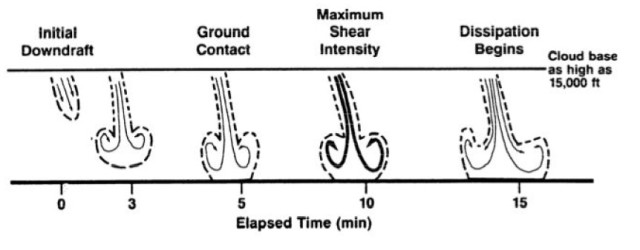
Microburst detection and avoidance
A primer for pilots
By Captain Shem Malmquist
You’re on final and there are thunderstorms around. As you line up still 10 miles out you notice that you can see the airport but there is some light rain in the vicinity of short final. Lightning is present in the area, but you are below the bases. Your radar is set to about 5 degrees nose up and not painting anything other than the light rain you see. There are no windshear warnings and you are equipped with predictive windshear. As you approach the FAF the aircraft in front of you, a CRJ 700, lands. The tower asks them for a ride report and they report “smooth all the way down”. You can still see the airport through the continuing light rain. Are you safe to continue?
The answer to this question depends. I think we all know that most pilots would continue in this scenario. Is the airport equipped with a microburst detection system? “A what?” you ask. Is that not the same as a windshear detection system? Nope, we’ll get to that shortly.
Most all of the current guidance for microbursts follows along a series of things to look for and then recommendations should you encounter it. However, the items to look for are so common that they are often ignored, or, if followed, would preclude so many airline operations they would grind the system to a halt.
Before I go further, I have a deep concern that we have convoluted “windshear” and “microburst”. We can have a windshear from just the rolling effect that wind has over the surface. The surface friction leads to the air essentially rolling over on itself and causing gusts. We can also have a windshear in a similar manner with two different airmasses near each other. Adding a bit of speed is really all that’s needed to handle this sort of “shear”. It is more of a “gust additive”, as that is the threat. That stated, the below is from the FAA Windshear Training Guide AC 00-54. It is important to remember that the HIGH items are mostly aspects that will occur once a microburst has “dropped”:
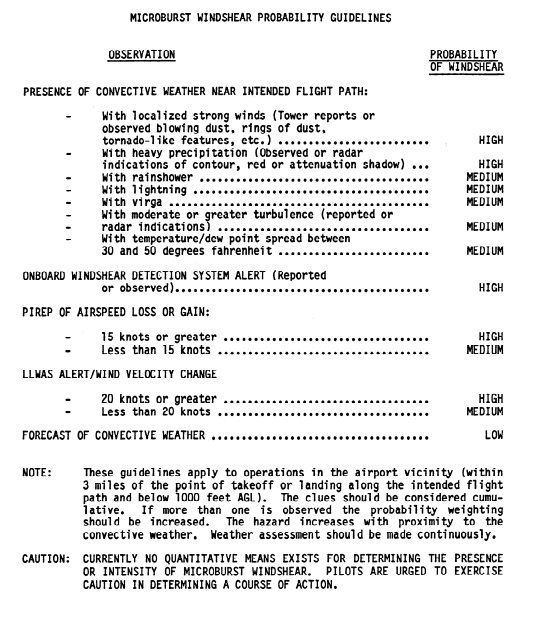
While the “high” probability items are fairly straight forward, the “medium” are not. Also, notice the caution? Clearly there are some gaps. With just minimal tools to avoid it in the first place, the industry turned to how to recognize you’re in a microburst and how to best survive the event. These started with a description and image, likely similar to this one:
That would be followed by something like this:

or maybe one like this:
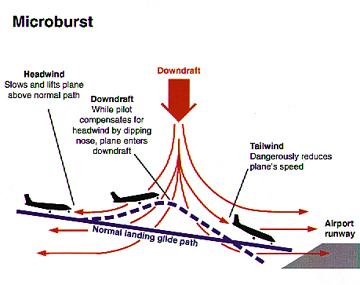
The guidance for windshear recovery is well known and practiced in training often, but I will add it here as a good reminder, although the following is very generic (out of the FAA Windshear Training Guide) and so does not reflect methods that may be applicable to some current designs, it never hurts to review:
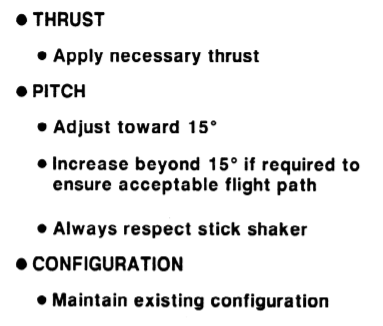
All that is great, but there are two parts to preventing a problem. Astronaut Frank Borman (Col, USAF, Ret.) famously stated “A superior pilot uses his superior judgment to avoid situations which require the use of his superior skill”. For the most part, the guidance to on microbursts pilots falls into the “skill” part, and the avoidance of them is left to their intuition or just experience. Unfortunately, microbursts are rare enough that experience is likely not going to be enough. This may also be the reason we do not see more accidents. The odds of a microburst occurring very near the approach or departure path of an airport just when an airplane is there is, fortunately, quite low.
Several years ago, while researching material for another project, I had some discussions with a few folks at MIT’s Lincoln Laboratory. The Lincoln Lab had developed an algorithm to detect windshear that was not based on the “after the fact”. To understand this, look back at the “typical descriptions” we get of microbursts. The focus is all on the way a developed microburst manifests itself and what a pilot would experience flying through it. It starts with a building headwind, then a downdraft and finally a tailwind. The cues pilots are taught are built around that. Windshear alerting systems, both ground based and airborne are designed to look for the differences in the outward flow. They detect lateral flow, parallel to the ground, and if there is enough of a differential they signal a windshear. These systems work well for telling you that a microburst has occurred, but what about detecting one that is about to occur. The below image was developed on work initially done by Dr. Fujita (yes, the same Fujita that originated the scale for tornadoes). This is showing where the water is in the storm, or “Vertically Integrated Liquid” (VIL).

The following images come from several papers out of the Lincoln Lab.

What you can see is that, for simplicity, a microburst starts as a large updraft holding water aloft. That water finally gets so heavy that the updraft cannot hold it anymore, and so it starts to fall. It may fall directly down, or may be offset quite a bit depending on winds, etc., As it falls it starts to evaporate, cooling it, and accelerating the flow. For practical purposes, the Lincoln Lab developed an algorithm that detects this mass of water aloft. The microburst detection systems they developed using this algorithm are now installed at approximately 67 U.S. airports and Hong Kong. They do not necessarily detect for every runway and the alert is not a “windshear alert” from ATC but rather a “microburst alert”.
Notice that in the earlier part of a microburst’s life cycle the rain is all aloft. It will not meet the “HIGH criteria in that windshear guidance above! Now consider how your radar is set. If you are following what most pilots do, setting just a few degrees up to remove terrain, you are, literally, under-scanning the threat! You will pick up next to nothing. Assuming that the Delta 191 crew was using “standard” techniques, they would not have been painting much on their radar until it was too late. On final, you are below the rain, or maybe just a bit is starting to fall in a thin line that winds its way through the updrafts – sort of a path-finder for the larger mass. Your radar is picking up nothing of significance and you can visually see the runway. All looks great! It is literally “suckering” you in. Then you get too close to avoid it and the mass comes down. Look at the next couple of images.


You do not want to be underneath one of these as it collapses on top of you! Going back to the vertical profile, below is an image a downburst (you can see my post here for more background on it). Can you tell where you want to scan for the danger?
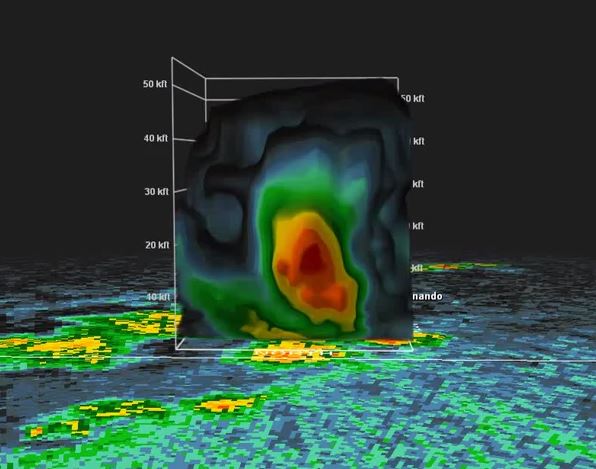
As you probably have surmised, the guidance in most radar manuals and instruction is generally telling us to scan too low to “see” the threat on approach and departure. The solution is to point your beam higher up. Pretty much all airborne radar that I am aware of have a maximum tilt of 15 degrees. Using the tilt formula, one degree equals 1,000 feet at 10 miles, you can see that even at 15 degrees up the maximum you can “see” is 15,000 feet above the aircraft (a bit more depending on your beam width, most large aircraft have approximately 3.5 degrees wide beams). You can use the formula to see where to scan to capture the threat at
The illustration below gives some insight.
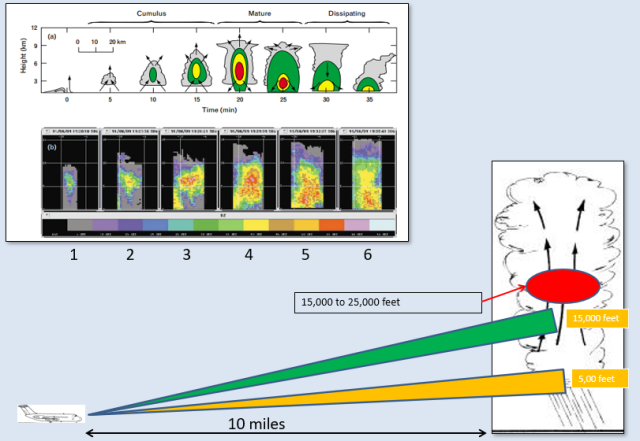
Have an automated system? Know how it works. Read the literature. Like any automated system, we must truly understand how it works to know how to get the information you need. It is very probable you’ll have to “work around” the auto mode to “see higher”. Some of these systems are further limited when they go into predictive windshear mode, limiting the vertical scan to increase the scan rate. Obviously, this creates a problem, but if you see more water aloft than down below, be careful. Pretty much the only way this can occur is hail, virga or an impending microburst. Of course, virga can be indication of a “dry” microburst as well.
I have used this in the real world several times now. A couple of times I was showing my F/O the technique before takeoff and pointing out how a storm looked like it met the profile for a microburst. On one occasion the storm was offset from the departure path so was not going to be a factor, but as we broke ground it “let loose” (several miles ahead and to our left) and we got a “windshear ahead” alert as we could see the bottom fall out of the storm. On another we were in Denver and as we started to taxi I pointed out that as we rolled the tilt up to 15 it went from nothing to green, yellow and red. I said “we are going to have to take a look at this when we get aligned with the runway, but we may need to delay”. Just 5 minutes later ATC called “microburst alert” and shut down the airport!
Even if you can’t get the beam high enough you might still be able to see high enough to get a slightly early warning of an “impending threat”. Also, there really is no point in scanning the weather under 10,000 feet. You really can’t tell whether what you’re seeing is convective or just low altitude heavy rain without tilting upwards.
One last caveat. Nothing is 100% sure. This method is just one more to put into your toolbox but continue to rely on all the cues you can get.

You must be logged in to post a comment.